2009 FORD SUPER DUTY key
[x] Cancel search: keyPage 9 of 103

Glow plug pre-heat indicator:
With the key in the on position,
the
light will illuminate if glow
plug heat is necessary as a starting aid. Wait until the light goes off
before starting. Refer toCold weather startingin theDrivingchapter
of this supplement. After the engine starts, the light should turn on. The
light should always illuminate at least momentarily when the engine is
cold and the ignition is turned to on. If it does not illuminate, the glow
plug system should be checked and repaired promptly to avoid difficulty
in cold starting.
Water in fuel:
E-Series
F-Super Duty
During refueling, it is possible for water-contaminated diesel fuel to be
pumped into your tank. Your vehicle’s fuel system is equipped with a fuel
filter/water separator to remove water from the fuel. The WATER IN
FUEL light will illuminate when the ignition is turned to start (as part of
the light function check) and when the FCM/HFCM has a significant
quantity of water in it.
If the light illuminates when the engine is running, stop the vehicle as
soon as safely possible, shut off the engine, then drain the FCM/HFCM.
Refer toDraining the FCM/HFCM and changing the fuel filtersin the
Maintenance and Specificationschapter of this supplement for the
drain procedure. Allowing water to stay in the system could result in
extensive damage to, or failure of, the fuel injection system.
WARNING:Do not drain the water separator while the engine is
running. Fuel may ignite if the separator is drained while the
engine is running or the vehicle is moving.
2009 Econoline(eco)
Supplement, 1st Printing
USA(fus)
Instrument Cluster
9
Page 11 of 103
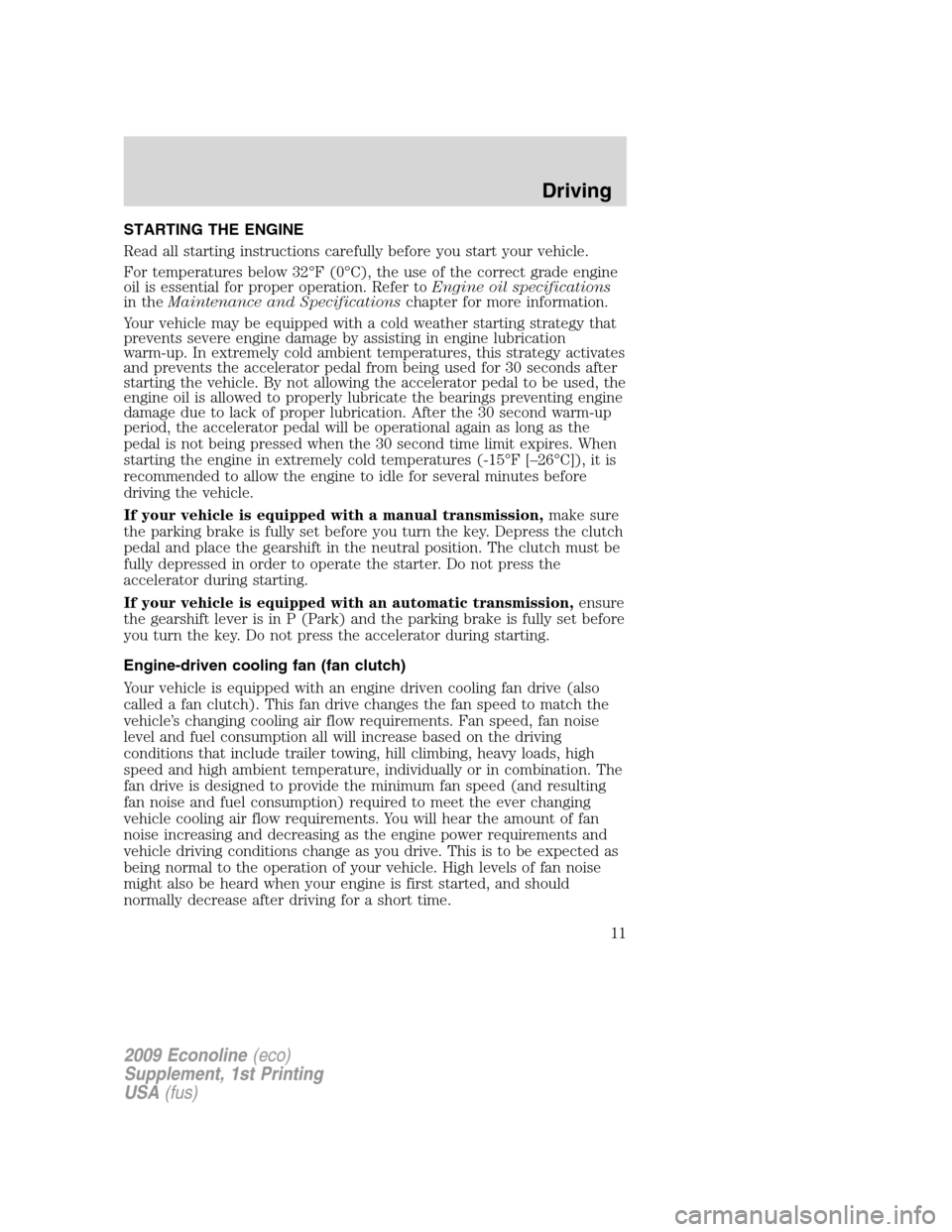
STARTING THE ENGINE
Read all starting instructions carefully before you start your vehicle.
For temperatures below 32°F (0°C), the use of the correct grade engine
oil is essential for proper operation. Refer toEngine oil specifications
in theMaintenance and Specificationschapter for more information.
Your vehicle may be equipped with a cold weather starting strategy that
prevents severe engine damage by assisting in engine lubrication
warm-up. In extremely cold ambient temperatures, this strategy activates
and prevents the accelerator pedal from being used for 30 seconds after
starting the vehicle. By not allowing the accelerator pedal to be used, the
engine oil is allowed to properly lubricate the bearings preventing engine
damage due to lack of proper lubrication. After the 30 second warm-up
period, the accelerator pedal will be operational again as long as the
pedal is not being pressed when the 30 second time limit expires. When
starting the engine in extremely cold temperatures (-15°F [–26°C]), it is
recommended to allow the engine to idle for several minutes before
driving the vehicle.
If your vehicle is equipped with a manual transmission,make sure
the parking brake is fully set before you turn the key. Depress the clutch
pedal and place the gearshift in the neutral position. The clutch must be
fully depressed in order to operate the starter. Do not press the
accelerator during starting.
If your vehicle is equipped with an automatic transmission,ensure
the gearshift lever is in P (Park) and the parking brake is fully set before
you turn the key. Do not press the accelerator during starting.
Engine-driven cooling fan (fan clutch)
Your vehicle is equipped with an engine driven cooling fan drive (also
called a fan clutch). This fan drive changes the fan speed to match the
vehicle’s changing cooling air flow requirements. Fan speed, fan noise
level and fuel consumption all will increase based on the driving
conditions that include trailer towing, hill climbing, heavy loads, high
speed and high ambient temperature, individually or in combination. The
fan drive is designed to provide the minimum fan speed (and resulting
fan noise and fuel consumption) required to meet the ever changing
vehicle cooling air flow requirements. You will hear the amount of fan
noise increasing and decreasing as the engine power requirements and
vehicle driving conditions change as you drive. This is to be expected as
being normal to the operation of your vehicle. High levels of fan noise
might also be heard when your engine is first started, and should
normally decrease after driving for a short time.
2009 Econoline(eco)
Supplement, 1st Printing
USA(fus)
Driving
11
Page 12 of 103
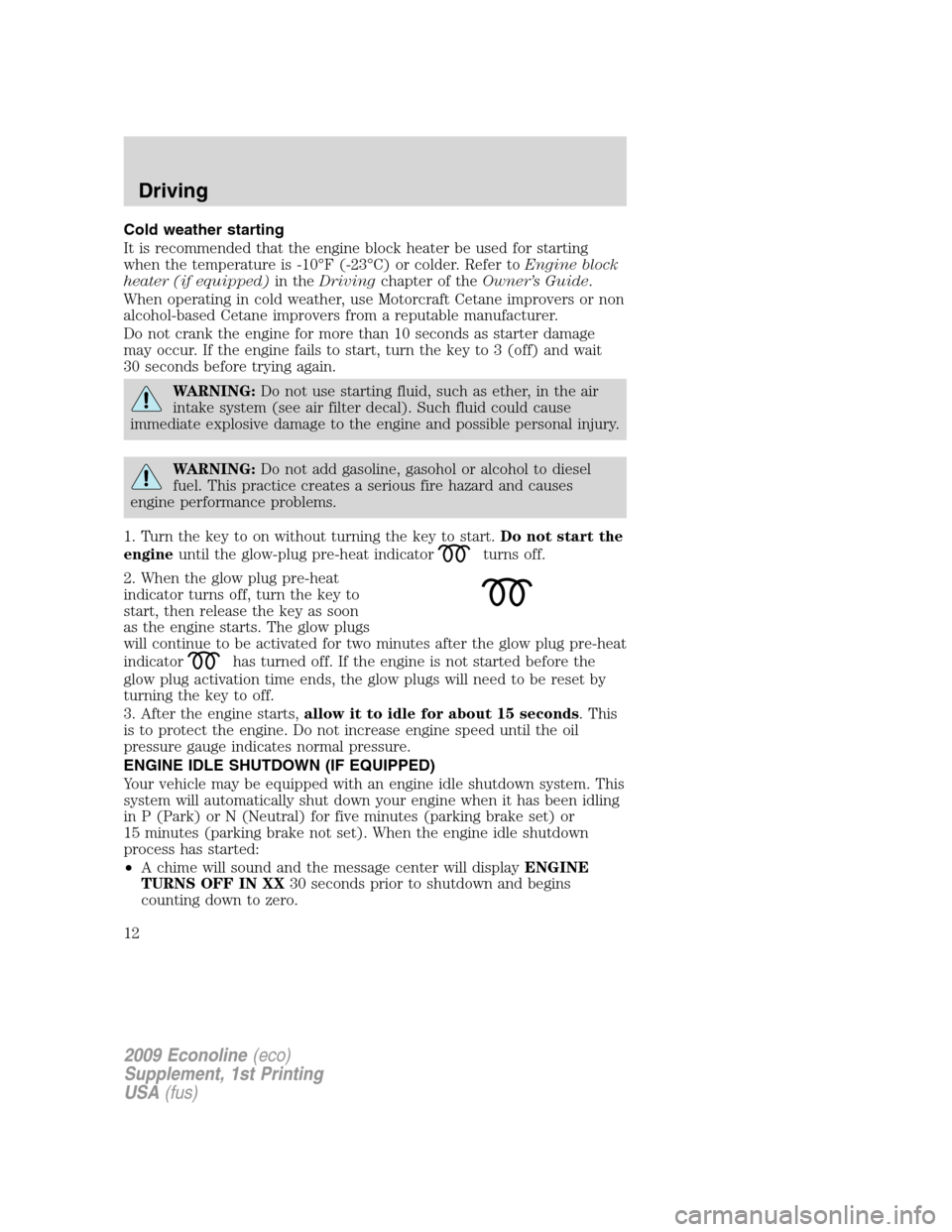
Cold weather starting
It is recommended that the engine block heater be used for starting
when the temperature is -10°F (-23°C) or colder. Refer toEngine block
heater (if equipped)in theDrivingchapter of theOwner’s Guide.
When operating in cold weather, use Motorcraft Cetane improvers or non
alcohol-based Cetane improvers from a reputable manufacturer.
Do not crank the engine for more than 10 seconds as starter damage
may occur. If the engine fails to start, turn the key to 3 (off) and wait
30 seconds before trying again.
WARNING:Do not use starting fluid, such as ether, in the air
intake system (see air filter decal). Such fluid could cause
immediate explosive damage to the engine and possible personal injury.
WARNING:Do not add gasoline, gasohol or alcohol to diesel
fuel. This practice creates a serious fire hazard and causes
engine performance problems.
1. Turn the key to on without turning the key to start.Do not start the
engineuntil the glow-plug pre-heat indicator
turns off.
2. When the glow plug pre-heat
indicator turns off, turn the key to
start, then release the key as soon
as the engine starts. The glow plugs
will continue to be activated for two minutes after the glow plug pre-heat
indicator
has turned off. If the engine is not started before the
glow plug activation time ends, the glow plugs will need to be reset by
turning the key to off.
3. After the engine starts,allow it to idle for about 15 seconds. This
is to protect the engine. Do not increase engine speed until the oil
pressure gauge indicates normal pressure.
ENGINE IDLE SHUTDOWN (IF EQUIPPED)
Your vehicle may be equipped with an engine idle shutdown system. This
system will automatically shut down your engine when it has been idling
in P (Park) or N (Neutral) for five minutes (parking brake set) or
15 minutes (parking brake not set). When the engine idle shutdown
process has started:
•A chime will sound and the message center will displayENGINE
TURNS OFF IN XX30 seconds prior to shutdown and begins
counting down to zero.
2009 Econoline(eco)
Supplement, 1st Printing
USA(fus)
Driving
12
Page 13 of 103
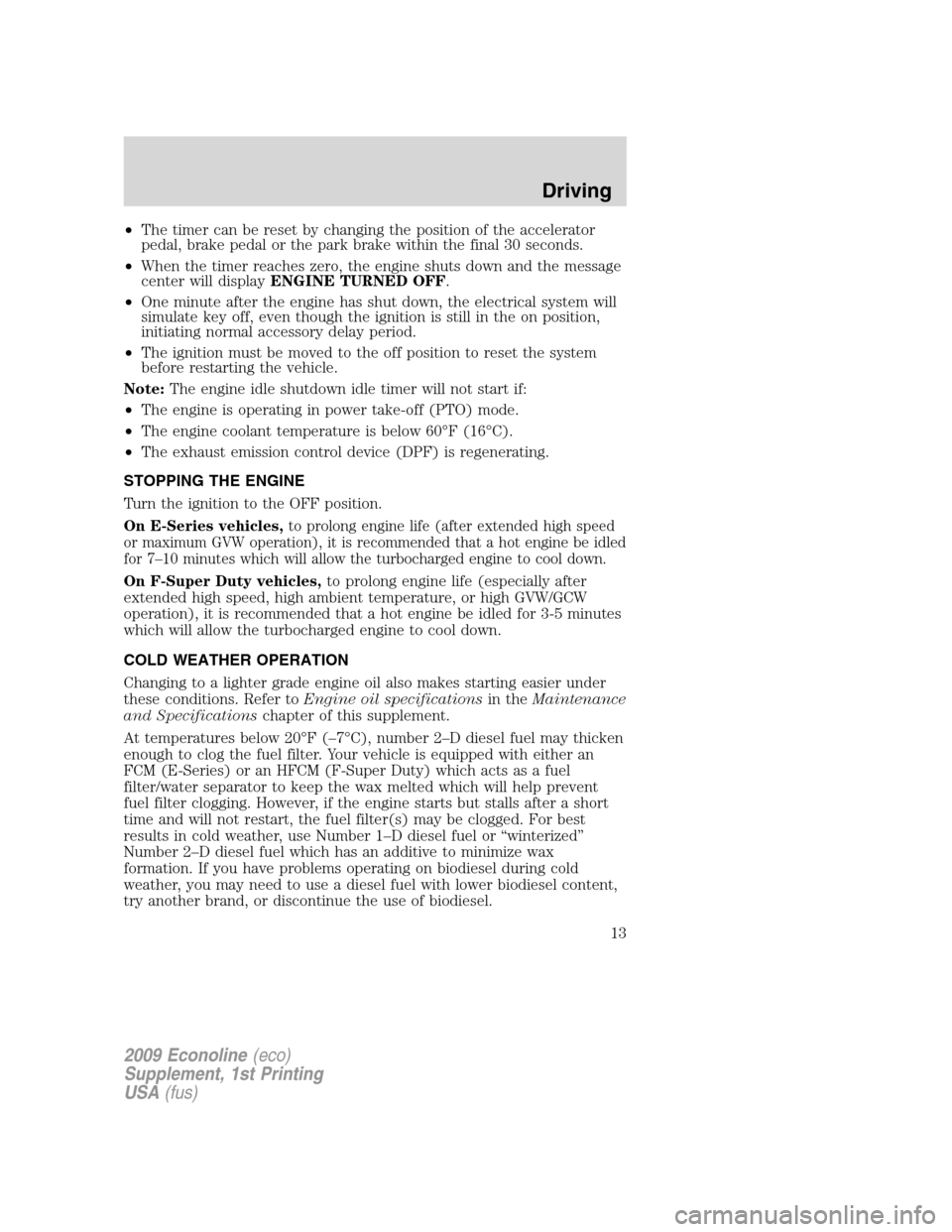
•The timer can be reset by changing the position of the accelerator
pedal, brake pedal or the park brake within the final 30 seconds.
•When the timer reaches zero, the engine shuts down and the message
center will displayENGINE TURNED OFF.
•One minute after the engine has shut down, the electrical system will
simulate key off, even though the ignition is still in the on position,
initiating normal accessory delay period.
•The ignition must be moved to the off position to reset the system
before restarting the vehicle.
Note:The engine idle shutdown idle timer will not start if:
•The engine is operating in power take-off (PTO) mode.
•The engine coolant temperature is below 60°F (16°C).
•The exhaust emission control device (DPF) is regenerating.
STOPPING THE ENGINE
Turn the ignition to the OFF position.
On E-Series vehicles,
to prolong engine life (after extended high speed
or maximum GVW operation), it is recommended that a hot engine be idled
for 7–10 minutes which will allow the turbocharged engine to cool down.
On F-Super Duty vehicles,to prolong engine life (especially after
extended high speed, high ambient temperature, or high GVW/GCW
operation), it is recommended that a hot engine be idled for 3-5 minutes
which will allow the turbocharged engine to cool down.
COLD WEATHER OPERATION
Changing to a lighter grade engine oil also makes starting easier under
these conditions. Refer toEngine oil specificationsin theMaintenance
and Specificationschapter of this supplement.
At temperatures below 20°F (–7°C), number 2–D diesel fuel may thicken
enough to clog the fuel filter. Your vehicle is equipped with either an
FCM (E-Series) or an HFCM (F-Super Duty) which acts as a fuel
filter/water separator to keep the wax melted which will help prevent
fuel filter clogging. However, if the engine starts but stalls after a short
time and will not restart, the fuel filter(s) may be clogged. For best
results in cold weather, use Number 1–D diesel fuel or “winterized”
Number 2–D diesel fuel which has an additive to minimize wax
formation. If you have problems operating on biodiesel during cold
weather, you may need to use a diesel fuel with lower biodiesel content,
try another brand, or discontinue the use of biodiesel.
2009 Econoline(eco)
Supplement, 1st Printing
USA(fus)
Driving
13
Page 38 of 103
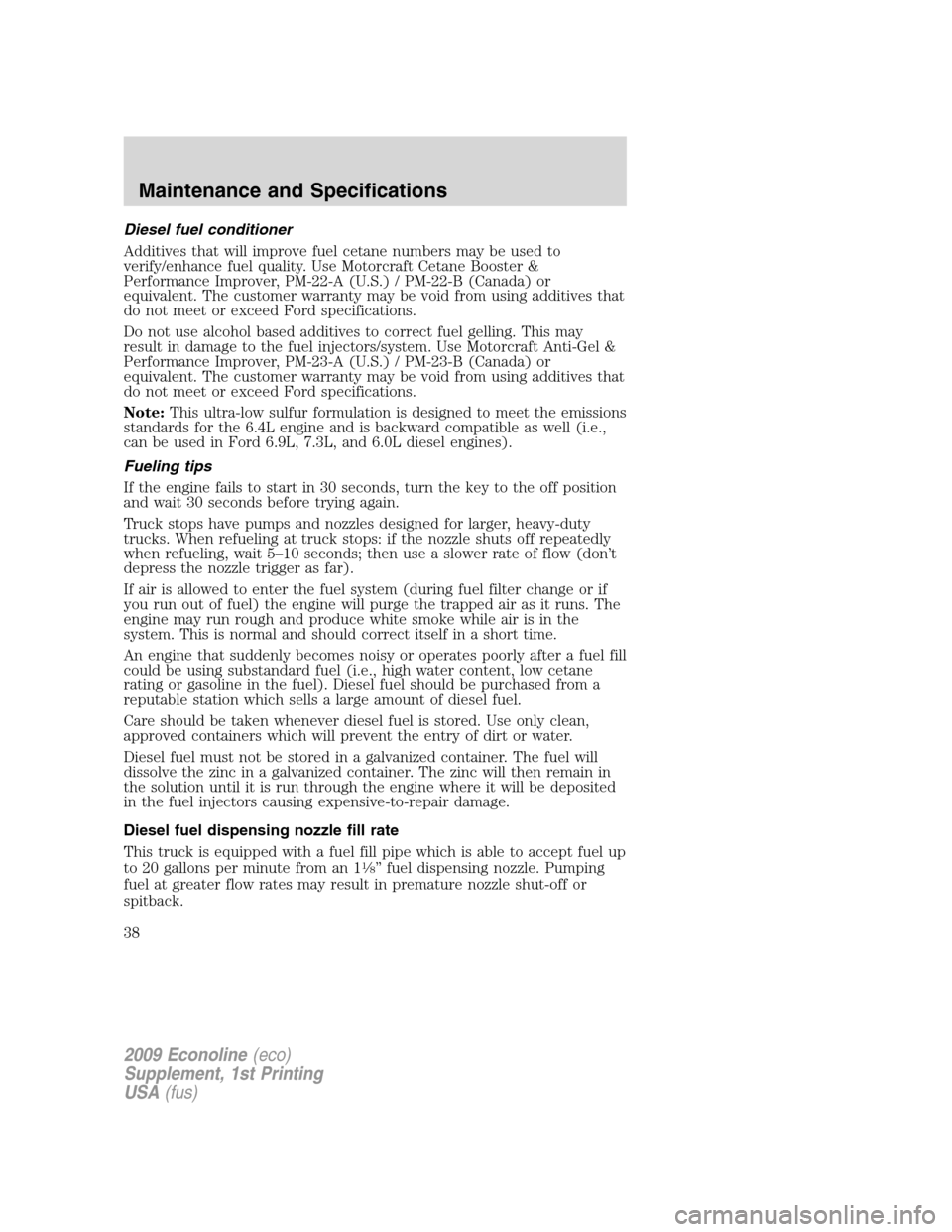
Diesel fuel conditioner
Additives that will improve fuel cetane numbers may be used to
verify/enhance fuel quality. Use Motorcraft Cetane Booster &
Performance Improver, PM-22-A (U.S.) / PM-22-B (Canada) or
equivalent. The customer warranty may be void from using additives that
do not meet or exceed Ford specifications.
Do not use alcohol based additives to correct fuel gelling. This may
result in damage to the fuel injectors/system. Use Motorcraft Anti-Gel &
Performance Improver, PM-23-A (U.S.) / PM-23-B (Canada) or
equivalent. The customer warranty may be void from using additives that
do not meet or exceed Ford specifications.
Note:This ultra-low sulfur formulation is designed to meet the emissions
standards for the 6.4L engine and is backward compatible as well (i.e.,
can be used in Ford 6.9L, 7.3L, and 6.0L diesel engines).
Fueling tips
If the engine fails to start in 30 seconds, turn the key to the off position
and wait 30 seconds before trying again.
Truck stops have pumps and nozzles designed for larger, heavy-duty
trucks. When refueling at truck stops: if the nozzle shuts off repeatedly
when refueling, wait 5–10 seconds; then use a slower rate of flow (don’t
depress the nozzle trigger as far).
If air is allowed to enter the fuel system (during fuel filter change or if
you run out of fuel) the engine will purge the trapped air as it runs. The
engine may run rough and produce white smoke while air is in the
system. This is normal and should correct itself in a short time.
An engine that suddenly becomes noisy or operates poorly after a fuel fill
could be using substandard fuel (i.e., high water content, low cetane
rating or gasoline in the fuel). Diesel fuel should be purchased from a
reputable station which sells a large amount of diesel fuel.
Care should be taken whenever diesel fuel is stored. Use only clean,
approved containers which will prevent the entry of dirt or water.
Diesel fuel must not be stored in a galvanized container. The fuel will
dissolve the zinc in a galvanized container. The zinc will then remain in
the solution until it is run through the engine where it will be deposited
in the fuel injectors causing expensive-to-repair damage.
Diesel fuel dispensing nozzle fill rate
This truck is equipped with a fuel fill pipe which is able to accept fuel up
to 20 gallons per minute from an 1
1�8” fuel dispensing nozzle. Pumping
fuel at greater flow rates may result in premature nozzle shut-off or
spitback.
2009 Econoline(eco)
Supplement, 1st Printing
USA(fus)
Maintenance and Specifications
38
Page 44 of 103

Installation - both
The engine will not run properly if the fuel filter is not installed
in housing.
1. Install the new fuel filter and cap seal into the fuel filter housing.
Refer toMotorcraft Part Numberslater in this chapter for the fuel filter
part number.
2. Tighten cap onto fuel filter housing slowly, allowing fuel to soak into
the fuel filter element. Tighten cap until it contacts the housing.
Turn the ignition key to on for 30 seconds, then turn it to off. Do this a
total of six times in a row to purge any trapped air from the fuel system.
Replace the filter bowl O-ring with new seal (included in filter kit) every
time you service the filter.
After filter service, a no start or rough running engine may indicate that
air is entering the system through the filter bowl seal or drain. Make sure
the drain lever is pointing rearward and stowed against the HFCM case.
Using a fuel which has more than average impurities may require
the fuel filter to be replaced more frequently than the service
interval specifies.
ENGINE OIL
Checking the engine oil level
Because it is normal to add some oil between oil changes, check your
engine oil level each time you stop for fuel. To check the engine oil level
consistently and accurately, the following procedure is recommended:
1. Have engine at normal operating temperature (at least into the
NORMAL range on the engine coolant temperature gauge).
2. Park the vehicle on a level surface, then turn off the engine and open
the hood.
3. Allow at least20 minutesafter engine shutdown to ensure that the
oil contained in the upper parts of the engine has returned to the oil
pan.
4. Protecting yourself from engine heat, pull out the dipstick, wipe it
clean and reinsert fully.
5. Read oil level on both sides of dipstick and use highest level (reading)
for the actual engine oil level.
6. Maintain the oil level between MIN and MAX or the ADD and
OPERATING RANGE on the dipstick by adding oil as required. The
2009 Econoline(eco)
Supplement, 1st Printing
USA(fus)
Maintenance and Specifications
44
Page 55 of 103
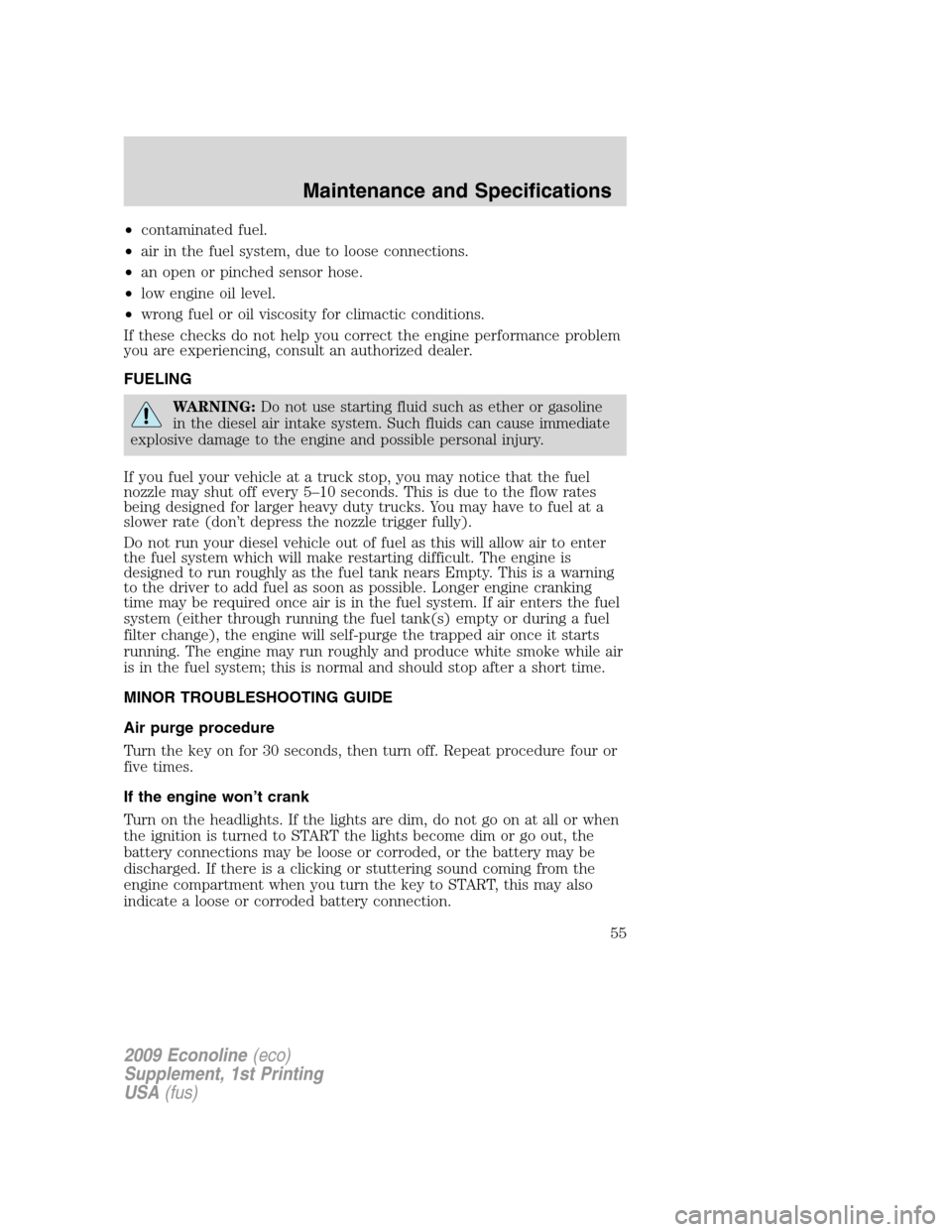
•contaminated fuel.
•air in the fuel system, due to loose connections.
•an open or pinched sensor hose.
•low engine oil level.
•wrong fuel or oil viscosity for climactic conditions.
If these checks do not help you correct the engine performance problem
you are experiencing, consult an authorized dealer.
FUELING
WARNING:Do not use starting fluid such as ether or gasoline
in the diesel air intake system. Such fluids can cause immediate
explosive damage to the engine and possible personal injury.
If you fuel your vehicle at a truck stop, you may notice that the fuel
nozzle may shut off every 5–10 seconds. This is due to the flow rates
being designed for larger heavy duty trucks. You may have to fuel at a
slower rate (don’t depress the nozzle trigger fully).
Do not run your diesel vehicle out of fuel as this will allow air to enter
the fuel system which will make restarting difficult. The engine is
designed to run roughly as the fuel tank nears Empty. This is a warning
to the driver to add fuel as soon as possible. Longer engine cranking
time may be required once air is in the fuel system. If air enters the fuel
system (either through running the fuel tank(s) empty or during a fuel
filter change), the engine will self-purge the trapped air once it starts
running. The engine may run roughly and produce white smoke while air
is in the fuel system; this is normal and should stop after a short time.
MINOR TROUBLESHOOTING GUIDE
Air purge procedure
Turn the key on for 30 seconds, then turn off. Repeat procedure four or
five times.
If the engine won’t crank
Turn on the headlights. If the lights are dim, do not go on at all or when
the ignition is turned to START the lights become dim or go out, the
battery connections may be loose or corroded, or the battery may be
discharged. If there is a clicking or stuttering sound coming from the
engine compartment when you turn the key to START, this may also
indicate a loose or corroded battery connection.
2009 Econoline(eco)
Supplement, 1st Printing
USA(fus)
Maintenance and Specifications
55
Page 56 of 103
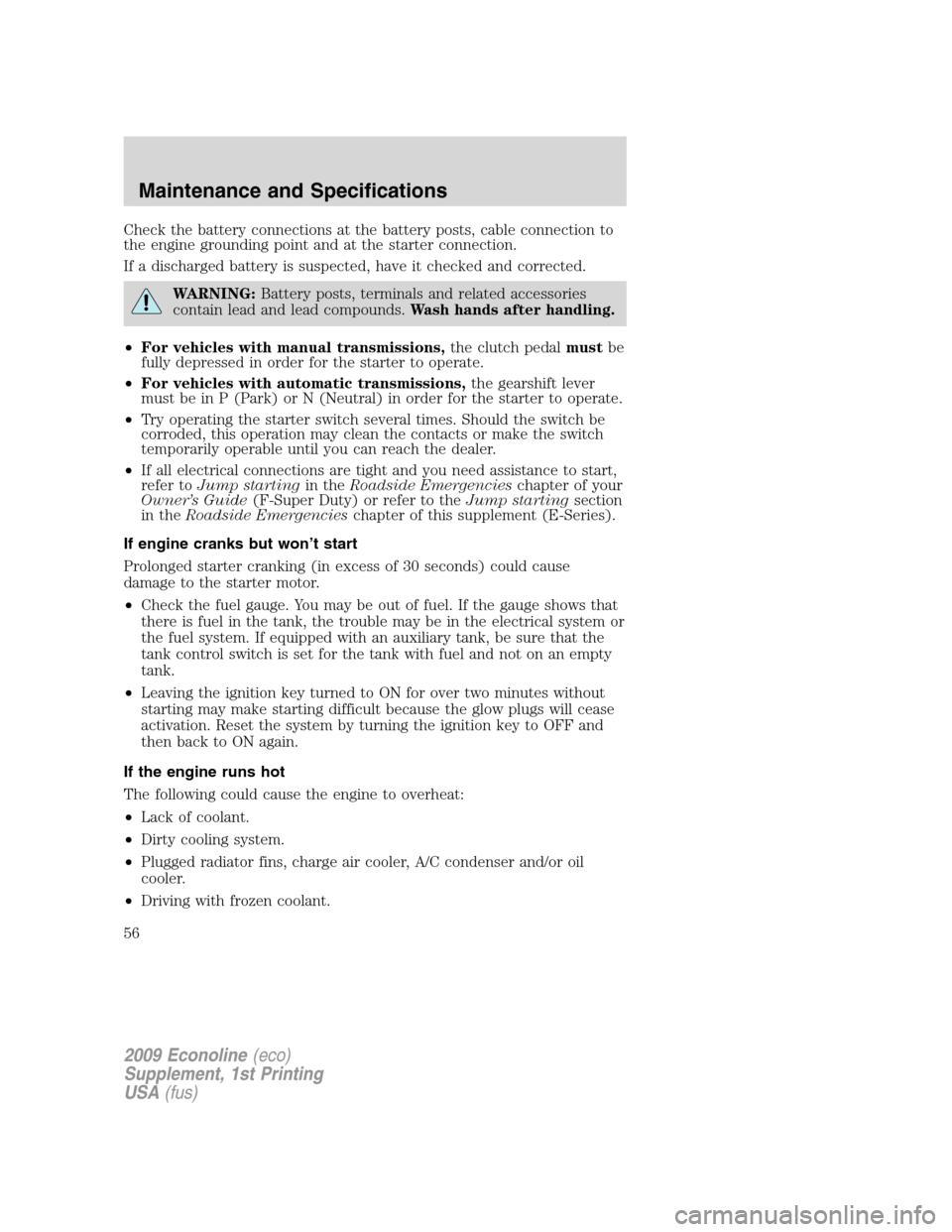
Check the battery connections at the battery posts, cable connection to
the engine grounding point and at the starter connection.
If a discharged battery is suspected, have it checked and corrected.
WARNING:Battery posts, terminals and related accessories
contain lead and lead compounds.Wash hands after handling.
•For vehicles with manual transmissions,the clutch pedalmustbe
fully depressed in order for the starter to operate.
•For vehicles with automatic transmissions,the gearshift lever
must be in P (Park) or N (Neutral) in order for the starter to operate.
•Try operating the starter switch several times. Should the switch be
corroded, this operation may clean the contacts or make the switch
temporarily operable until you can reach the dealer.
•If all electrical connections are tight and you need assistance to start,
refer toJump startingin theRoadside Emergencieschapter of your
Owner’s Guide(F-Super Duty) or refer to theJump startingsection
in theRoadside Emergencieschapter of this supplement (E-Series).
If engine cranks but won’t start
Prolonged starter cranking (in excess of 30 seconds) could cause
damage to the starter motor.
•Check the fuel gauge. You may be out of fuel. If the gauge shows that
there is fuel in the tank, the trouble may be in the electrical system or
the fuel system. If equipped with an auxiliary tank, be sure that the
tank control switch is set for the tank with fuel and not on an empty
tank.
•Leaving the ignition key turned to ON for over two minutes without
starting may make starting difficult because the glow plugs will cease
activation. Reset the system by turning the ignition key to OFF and
then back to ON again.
If the engine runs hot
The following could cause the engine to overheat:
•Lack of coolant.
•Dirty cooling system.
•Plugged radiator fins, charge air cooler, A/C condenser and/or oil
cooler.
•Driving with frozen coolant.
2009 Econoline(eco)
Supplement, 1st Printing
USA(fus)
Maintenance and Specifications
56